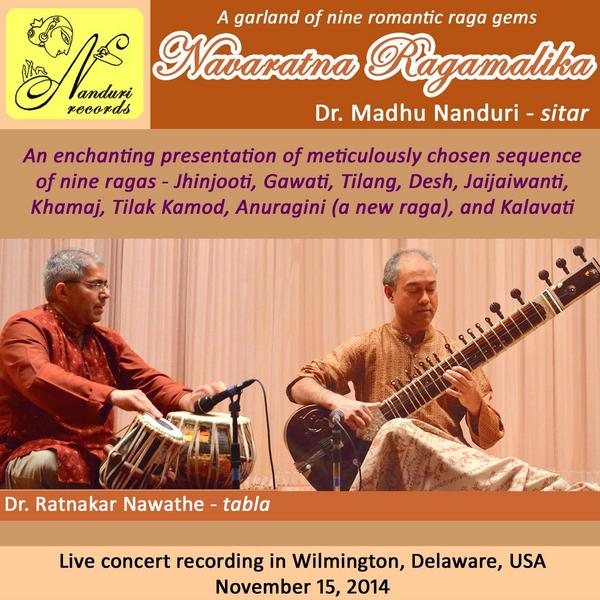
An enchanting presentation of meticulously chosen sequence of nine ragas - Jhinjooti, Gawati, Tilang, Desh, Jaijaiwanti, Khamaj, Tilak Kamod, Anuragini (a new raga), and Kalavati by Dr. Madhu Nanduri, a direct disciple of Ustad Vilayat Khan.
Navaratna (nine gems), Ragamalika (garland of ragas) – ‘Navaratna Ragamalika’ is a 24 minute long composition conceived, composed, and presented as a garland of nine raga gems. All the nine ragas in this presentation belong to Khamaj thaat and express romantic sentiment – shringar rasa in the Indian music parlance.
Listen to a sample below. For complete track and notes, scroll further.
About the music
Most ragas of Khamaj thaat are best expressed between 6 p.m. and midnight, ideally between 8 p.m. and midnight. The scene in this presentation could be visualized as a rendezvous of the lover and the beloved on a moonlit night. In Indian classical literature, the heroine who meets her lover on a moonlit night is called jyotsna abhisarika and the one who meets on a dark night is called krishna abhisarika. The word jyotsna means moonlight and krishna means darkness.
This presentation, from start to finish, is a steady flow of madhurya (sweetness or nectar) with no trace of melancholy. The melody of sitar and the rhythm of tabla do not seem to be two separate entities and proceed as a single stream.
The meticulously chosen sequence of nine ragas in this presentation begins with the raga Jhinjooti. The short alap (un-metered rendering of the raga) of about two minutes, paints a picture of lover Krishna at the sanketha sthala (trysting place) waiting for his beloved Radha. Though happy and in an elated mood, there is a trace of lurking anxiety caused by the delayed arrival of Radha. The state of mind continues through the second raga Gawati although with a subtle change. The anxiety vanishes as Radha is sighted at a short distance. Raga Tilang expresses this feeling of elation and excitement. Raga Desh follows with an expression of an absolutely happy mood of carefree abandonment in the stillness of cool moonlight and the intoxicating fragrance of jasmines. A picture of a beautiful garden with a variety of flowering trees and creepers, bright moonlight, and a cool gentle breeze laden with intoxicating fragrance is painted by successive ragas Jaijaiwanti, Khamaj, Tilak Kamod, Anuragini*, and Kalavati. This enchanting scene provides appropriate background for the romance of Radha and Krishna. In the play of jhala (fast-paced rhythmic concluding phase of the rendition) towards the end, all the ragas are repeated in the same sequence in an accelerated tempo suggesting the climactic ecstasy of the union of Radha and Krishna.
- Anuragini, conceived by Dr. Madhu Nanduri, is a new raga, which is an offshoot of raga Rageshwari.
About the accompanying artist
Dr. Ratnakar Nawathe started his initial training in tabla under Pandit Chandrakant Shirodkar of Bombay. He learnt tabla of the Delhi and Farukhabad gharanas until 1988 after which he relocated to United States and earned a doctoral degree in electrical engineering. Ratnakar has continued training in America under the great tabla player Pandit Swapan Chaudhuri, an exponent of the Lucknow gharana. Dr. Nawathe has played on All India Radio and TV in Bombay. He has accompanied many accomplished Indian classical vocalists and instrumentalists. In addition to performances, he also teaches tabla in Pennsylvania, USA.
Credits
Notes: NamPaaSaa
Cover photo: Jeni Barton
